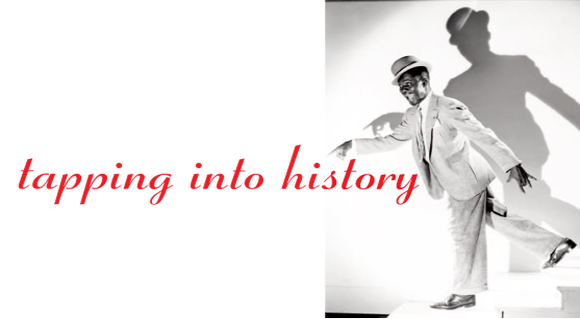When one hears the words “Tap Dance” the first image that may come to mind is the ballet-like elegance and ballroom style of Fred Astaire and Ginger Rodgers, or the effortless grace and charisma of Gene Kelly. Others may identify this American dance style with a specific musical such as “Forty Second Street.” Those who have followed tap dance in more recent years may immediately think of the intricate footwork and dynamic speed of Savion Glover. Regardless of how one thinks of this American style of dance, the fact is that tap dancers throughout history have found themselves shuffling and time stepping in the shadows of what are believed to be the more “elite” styles of dance.
In 1989, however, tap dance managed to briefly break out of those shadows when a joint Senate and House of Representatives resolution was passed declaring May 25th as “National Tap Dance Day.” Ironically, the date of May 25th holds no meaningful significance to Astaire, Rodgers, or Kelly and the date is completely unrelated to any famous tap dancing musical. May 25th was the date chosen for National Tap Dance Day because is the birthday of Bill “Bojangles” Robinson. You may remember Robinson as the sweet man who performed adorable duets with the tiny, curly-haired cutie, Shirley Temple, however, his birthday was not chosen for those performances, but rather for the enormous contributions he made to the art of tap dance.
EARLY LIFE AND STAIR DANCE
Bill Robinson started dancing at a very early age and as a young adult gained success by winning numerous dance contests. He eventually became a vaudeville performer and was the first African-American soloist to perform in white vaudeville. After dancing in vaudeville for sixteen years, he introduced his solo act of “Stair Dance.” “Stair Dance,” which would become his signature piece both on and off screen throughout his career, set him apart from every other dancer in vaudeville, and allowed him to lay claim to the title of “World’s Greatest Dancer.”
Luckily, various performances of Robinson’s “Stair Dance” have been preserved on film. In these films, Robinson dances effortlessly up and down a specially designed staircase. He never once loses his balance and somehow manages to keep in perfect time with the music despite the complex and dangerous choreography. The tapping is a fast combination of intricate footwork, which is executed with confidence and ease. One tiny misstep could have destroyed the delicately crafted choreography, but Robinson delivers the entire piece without hesitation.
INFLUENCE ON TAP TECHNIQUE
I can still hear the sound of my childhood tap dance teacher repeat the phrase “on your toes” over and over again. Today as a tap dance teacher, I too often remind my students to keep their weight forward or to stay on their toes. This is the lingo tap instructors use to encourage their students to shift their weight to the balls of their feet. This position is an essential piece of tap dance technique, even though it can be a difficult concept for the beginning tapper to master.
Similar to the way one would accept the rules of a new language without question, students never seem to ask why this specific weight placement is mandatory in tap dance. The fact is that Bill Robinson is the one known for bringing tap dance “up on its toes.” Before Robinson, tap dancers had a much more flat-footed style. Robinson’s new approach to technique enabled him to execute more complex combinations and increase speed, which confused, fascinated, and inspired many onlookers. Robinson’s technique became the foundation for all tap dancers that followed and his contributions to technique are still being used today.
SEGREGATED HOLLYWOOD
Although Bill Robinson performed many solos onscreen in several black-cast musical films, he became most known for his duets with Shirley Temple. In the thirties, joining black and white actors on screen was considered taboo, but Robinson’s match with Temple did not raise too many eyebrows. Their interaction was considered “innocent” because Temple was a child, and therefore no romantic interest between characters could be implied. Throughout his career, his only long-lasting female dance partnership had been with Shirley Temple. Although he had great success throughout his life, many believe that his success was limited due to the strict race regulations that he and numerous African-American entertainers encountered. Luckily, for today’s tap dancers, there is much written about Bojangles, and many of his famous, as well as rare performances are preserved on film.
What did Fred Astaire and
Eleanor Powell think?
Although segregated Hollywood prevented dancers of different races from performing together on film, they could not stop the mutual respect that these artists had for one another. Throughout their careers, both Fred Astaire and Eleanor Powell separately paid tribute to Robinson in well-executed impersonation routines. Astaire worked diligently to trade his natural ballet-like style for the fast paced spins, stops, and flowing arms of Bojangles in the piece titled “Bojangles of Harlem.” Due to the strict moral codes of the 1930’s, Eleanor Powell and Robinson were never allowed to perform together on the silver screen even though they were very good friends and often performed together at various private parties. In Broadway Melody of 1938, Powell paid tribute to her friend, Bill Robinson, in an athletic tap number. The piece appeared in a section of the film in which guests dressed up as their favorite entertainers at a costume ball.
It is important to note that both Powell and Astaire’s tributes to Robinson were performed in blackface. Contrary to what is considered offensive in the twenty-first century, these two 1930’s blackface impersonations were meant to be tasteful and were performed out of complete respect for Bill Robinson. Although these tributes indicate the admiration that these tap dancers had for each other, it is disheartening that the moral codes of the 1930’s were impossibly strict. It would have been a privilege for any tap dancer, then or now, to be able to see a duet performed by Robinson and Astaire, or by Powell and Robinson. It is nice to know, however, that the dancers themselves probably wished that Hollywood’s strict rules had been different.
Remembering Bojangles
Much like Bill Robinson who found himself limited by the narrow mindset of a segregated Hollywood, tap dancers in the twenty-first century often find themselves in the shadows of the Ballet and Modern dance worlds. May 25th not only recognizes the talent and contributions that Bojangles made to the world of tap, but it also celebrates tap dance as a legitimate dance form, in hope that someday tap dancers across the country will receive the recognition that they deserve.
As you watch your favorite tiny dancers draped in sequins and an oversized top hat shuffling across the stage at a local dance recital, perhaps you will take a moment to reflect on the contributions Bill Robinson made to the world of tap dance.




